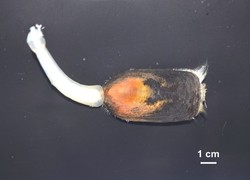Press Release
- Nature & Parks
Publication of the Ministry of the Environment, Japan, Marine Life Red List
1. Red List of Marine Life
Meanwhile, marine life except for some species, had not been assessed for extinction risk. However, MOEJ began to examine this issue in FY2012, in response to the growing interest in marine life, such as the promotion of "evaluation of the scarcity of marine organisms" as part of the Marine Biodiversity Conservation Strategy (decided by MOEJ in March 2011).
In FY2012, the first year of the effort, discussions on evaluation of the scarcity of marine organisms were held (Press release: http://www.env.go.jp/press/16534.html). MOEJ worked with the Fisheries Agency of Japan to organize the evaluation method, evaluation target, and evaluation system. (Reference 1).
Based on the above mentioned work, the MOEJ started extinction risk assessment in FY2013 for species other than those migrating across wide areas, those subject to resource assessment in the bilateral or multilateral fisheries agreements, and those subject to the Fisheries Agency’s resource assessment, as well as small whales. The species that have already been assessed for the extinction risks in the MOEJ Red List (Terrestrial Area) are also excluded from consideration.
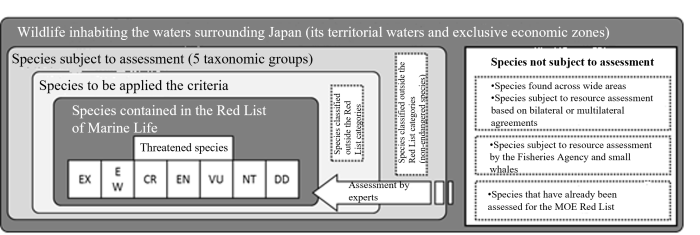
Figure: The scope of assessment for the MOEJ Marine Life Red List
MOEJ established a committee to select and assess threatened marine species, which were classified into five taxonomic groups: (1) fishes, (2) corals, (3) crustaceans, (4) mollusks (cephalopod) and (5) other invertebrates (precious coral, annelids, brachiopods, etc.). Subcommittees of experts specialized in the respective taxonomic groups were established under the committee and evaluated the extinction risks of the species (Reference 2). After deciding on basic assessment methods (Reference 3) and basic criteria of selecting species for assessment (Reference 4), the subcommittees performed various kinds of assessments. The criteria and categories are the same as those (Reference 5) used for the MOEJ Red List 2015 for terrestrial species published in 2015 (Press release: http://www.env.go.jp/press/101457.html).
Outline of the MOEJ Red List Category:
| Extinct (EX) | Species considered extinct in Japan | |
| Extinct in the Wild (EW) | Species surviving only in captivity or in cultivation | |
| Threatened | Threatened IA (Critically Endangered (CR) in IUCN Red List category) | Extremely high risk of extinction in the wild in the very near future |
| Threatened IB (Endangered (EN)) |
Not as severe as Threatened IA, but at high risk of extinction in the wild in the near future. | |
| Threatened II (Vulnerable (VU)) |
Species at increasing risk of extinction | |
| Near Threatened (NT) | A species at low risk of extinction at present, but may transition to the Threatened categories depending on changes in habitat conditions. | |
| Data Deficient (DD) | Species for which sufficient data are not available for assessment* | |
| Threatened Local Population (LP) | Locally isolated population with a high probability of extinction | |
*A Data Deficient (DD) species is one for which sufficient data are currently unavailable, but could be classified as a Threatened species once detailed data become available.
Although inclusion in the Red List itself does not have any direct legal effect such as restricting hunting, the Red List is intended to serve as a tool for widely disseminating information to remind people of the extinction risks of wildlife (marine life) and to be used for various purposes.
2. Findings from the compilation of the MOEJ Marine Life Red List
Table: Number of Species Included in MOEJ Marine Life Red List (PDF)
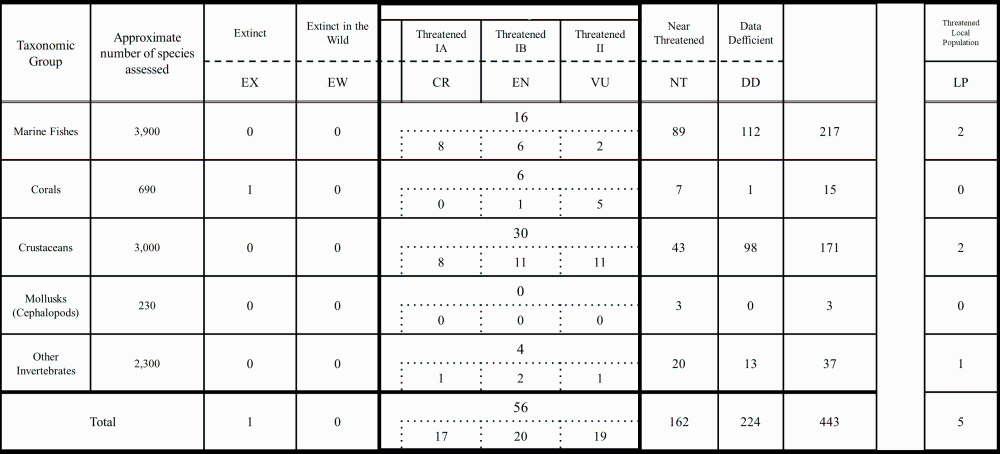
Appendix 1 shows the MOEJ Marine Life Red List of each taxonomic group. Appendix 2 summarizes findings revealed by the compilation of the Marine Life Red List for each taxonomic group. The following are summaries of the findings.
○ A total of 56 species have been selected as threatened species.
- The three categories, Threatened IA (CR) Threatened IB (EN), and Threatened II (VU) are collectively referred to as "Threatened species” . Threatened species are considered at relatively high risk of extinction within each taxonomic group in the future, and a total of 56 species have been selected as threatened species by the assessment for the Marine Life Red List.
The following outlines trends of threatened species by taxonomic group:
・A total of 16 species of fish has been categorized as threatened species in the MOEJ Marine Red List. Many of them are found in coastal areas of warmer regions, such as the Nansei Islands, and they are dependent on certain environmental conditions, or have limited habitat ranges.
・A total of six species of corals have been classified as threatened species in the MOEJ Marine Life Red List. These species are characterized by their localized habitat areas or extremely fragmented ranges. It is found that they are rarely confirmed and face an increasing risk of extinction.
・A total of 30 species of crustaceans are categorized as Threatened Species. Many of them inhabit mudflats and submarine caves in the Nansei Islands. Some species are parasitic, while others are mutualistic. It was found that these species are at increasing risk of extinction.
・There are no mollusks (cephalopods) falling into Threatened species, but three species have been listed in the Near Threatened category. All of them inhabit coastal areas and need such environments as sandy mud in an inland bay, stone shores (stone and rocky shores) and coral reefs during their life cycles. Coastal development has been found attributable to an increased risk of extinction.
・A total of four species in the Other Invertebrates group have been categorized as Threatened Species. All of them are found in mudflats (and shallow seas off the mudflats). It is found that many of the species inhabiting mudflats are diminishing in their ranges in recent years and facing an increasing risk of extinction.
○ Many species have been categorized as Data Deficient (DD).
○ There has been one species determined as Extinct (EX).
3. Notable species categories (ranks) and reasons for their evaluation (excerpt from Appendix 3)
[Fishes]
| English name: Giant grouper Threatened IA(CR) |
Photos courtesy of Kanagawa Prefectural Museum of Natural History (Photographed by Hiroshi Senou) |
| Scientific name: Epinephelus lanceolatus | |
|
【Description of species and basis for categorization】 This species is especially large among the Serranidae family and can grow to about 130 cm in length when it becomes mature. As giant groupers are solitary and thinly distributed on rocky or coral reefs in shallow seas, they are originally a rare species. In particular, there have been virtually no mature individuals caught or confirmed in the sea around Japan in recent years and the population in the Japanese coastal areas is considered extremely small. There is concern about further decline and therefore the species has been categorized as Threatened IA (CR). |
[Corals]
| English name: Ogasawara coral Extinct(EX) |
A specimen held by Tohoku University |
| Scientific name: Boninastrea boninensis | |
|
【Description of species and basis for categorization】 This species has never again been found in Japan’s waters after the new species description, despite numerous research projects conducted by researchers and the Ministry of the Environment. There have been no reports of this species from divers. Therefore, the species is regarded as extinct including in captivity or cultivation and classified as Extinct (EX). |
[Crustaceans]
| English name: Ogasawara fiddler crab Threatened IA(CR) |
|
| Scientific name: Paraleptuca boninensis | |
|
【Description of species and basis for categorization】 Ogasawara fiddler crab is endemic to Chichijima Island of the Ogasawara (Bonin) Islands. Although the species had been identified with Uca (Paraleptuca) crassipes distributed widely from the Pacific Ocean to the eastern Indian Ocean, the species was described as a new species in 2013. |
[Molluscs (Cephalopods)]
| English name: Intertidal octopus Near Threatened(NT) |
|
| Scientific name: Octopus incella | |
|
【Description of species and basis for categorization】 This species in the family Octopodidae is a small-sized octopus 15 to 20 cm in length, inhabiting coral reef shores and mudflats. This species has been found only on Okinawa Island and Sesoko Island in Japan. |
[Other Invertebrates]
| English name: Giant lingula Threatened IA(CR) |
|
| Scientific name: Lingula adamsi | |
|
【Description of species and basis for categorization】 Lingula adamsi is one of the world’s largest Lingula species and lives in mudflats and sandy coastal seafloors in shallow seas.
|
4. Future measures
MOEJ will disseminate the new Red List of Marine Life broadly to the public to promote understanding about the conservation of threatened species of wild fauna and flora. MOEJ will also distribute the Red List to relevant ministries and agencies as well as local governments to encourage them to factor in the conservation of endangered and threatened species in formulating their projects and programs.
With regard to species with a particularly high priority of protection among the species contained in the Red List of Marine Life, MOEJ will collect more data by conducting detailed surveys on habitat statuses, and implement necessary protective measures based on the survey results and natural and social conditions of habitat areas, such as by designating these species as nationally endangered species of wild fauna and flora based on the Act on Conservation of Endangered Species of Wild Fauna and Flora.
To conserve the endangered and threatened species on the MOEJ Red List of Marine Life well into the future, it is critical for various stakeholders to sincerely try to understand the significance of their survival. MOEJ will further promote its efforts to disseminate information, promote awareness-raising initiatives as well as implement effective conservation measures.
5. To get a copy of the Red List of Marine Life
(1) Download the file on the website of the Ministry of the Environment, (If you can’t have access to the Internet :)
(2) Visit the Office for Conservation of Endangered Species, Wildlife Division, Nature Conservation Bureau, Ministry of the Environment, Japan.
(3) By post. Send an A4-size return envelope to the address below. Please affix a 390-yen postage stamp (Japan domestic delivery postage) and write your name and address on the envelope.
| Office for Conservation of Endangered Species, Wildlife Division, Nature Conservation Bureau, Ministry of the Environment, Japan Central Government Building No. 5 1-2-2 Kasumigaseki, Chiyoda-ku, Tokyo, Japan 100-8975 |
Attached documents
(Downloadable from https://www.env.go.jp/press/103813.html)
Attachment Release of the MOEJ Red List of Marine Life
Appendix 1 (1) Red List of Marine Life [Fishes] (2017)
(2) Red List of Marine Life [Corals] (2017)
(3) Red List of Marine Life [Crustaceans] (2017)
(4) Red List of Marine Life [Mollusks (Cephalopods)] (2017)
(5) Red List of Marine Life [Other Invertebrates] (2017)
Appendix 2 Findings from the compilation of the Red List of Marine Life
Appendix 3 Assessed categories of species of special note in the Red List of Marine Life and the basis for categorization
Reference 1 (1) Basic assessment items for extinction risk assessment of marine species
(2) Guidelines for applying assessment criteria for extinction risk assessment of marine species
Reference 2 Organization for assessing species for the Red List of Marine Life
Reference 3 Table of basic assessment methods for the Red List of Marine Life
Reference 4 Table of basic criteria for selecting species for assessment for the Red List of Marine Life
Reference 5 Categories and criteria for extinction risk assessment of marine species
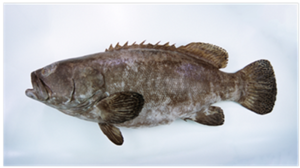
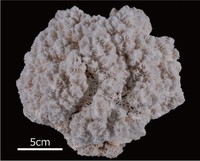
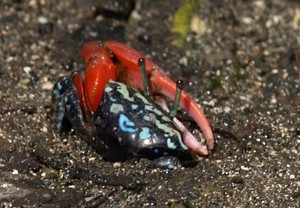
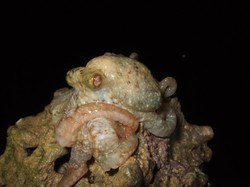 Photo courtesy of Natsumi Ono
Photo courtesy of Natsumi Ono